How can we extract energy from waste? In this week's Naked Scientists we explore the technology that turns muck into methane and consider the fertile issue of nutrient overload resulting from returning the finished products to farmland. And what about water? Why do we individually use ten times more water than we actually need, and what's the solution for a drought-stricken Britain? Plus, in the news, how astronomers have discovered evidence of life in the universe, but only down here on Earth, and the "ungentlemanly" conduct of the upper classes...
In this episode
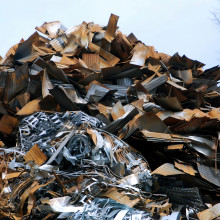
01:30 - Scavenging energy from your waste
Scavenging energy from your waste
with Dan Cooke, Viridor
Ben - According to government figures, we produce around 280 million tons of waste in the UK each year and while waste management may not seem glamorous especially when you consider that this includes dealing with over 90 million tonnes of animal slurry, it is essential. It's estimated that we could scavenge back as much as 5 terawatt hours of electricity from this waste per year if we use technologies such as anaerobic digesters.
We are joined today by Dan Cooke from Viridor which is one of the UK's leading recycling renewable energy and waste management companies. Dan, what are our priorities with waste management? What's most important?
Dan - Well, first and foremost, what we need to be doing is preventing waste in the first place - i.e. reducing it, thinking about what we need to buy, et cetera, designing our waste so that goods and items are reusable first and foremost, and then recyclable. Once it's hit the waste stream material then it's the priority for companies such as Viridor to recycle, recycle, and recycle, and then squeeze what energy we can out of what can't be recycled.
Ben - So what sorts of waste are we talking about here? Can we take literally anything and make the best of it or are we still restricted to what we can actually recycle, what we can re-use?
Dan - There is always a limit in terms of what can be recycled, whether it comes down to environmental benefit in doing so or economic feasibility, and benefit in doing so. So, while we can recycle probably much more than we are at the moment, there will always be residues that can't be recycled for either economic or environmental benefit that we have to still safely dispose of.
Ben - So, that would be a situation where for example, we have something that we could potentially claim back from our rubbish and turn back into nearly pristine material, but it might not be worth it either economically or in terms of energy purposes. In which case, what happens to it? 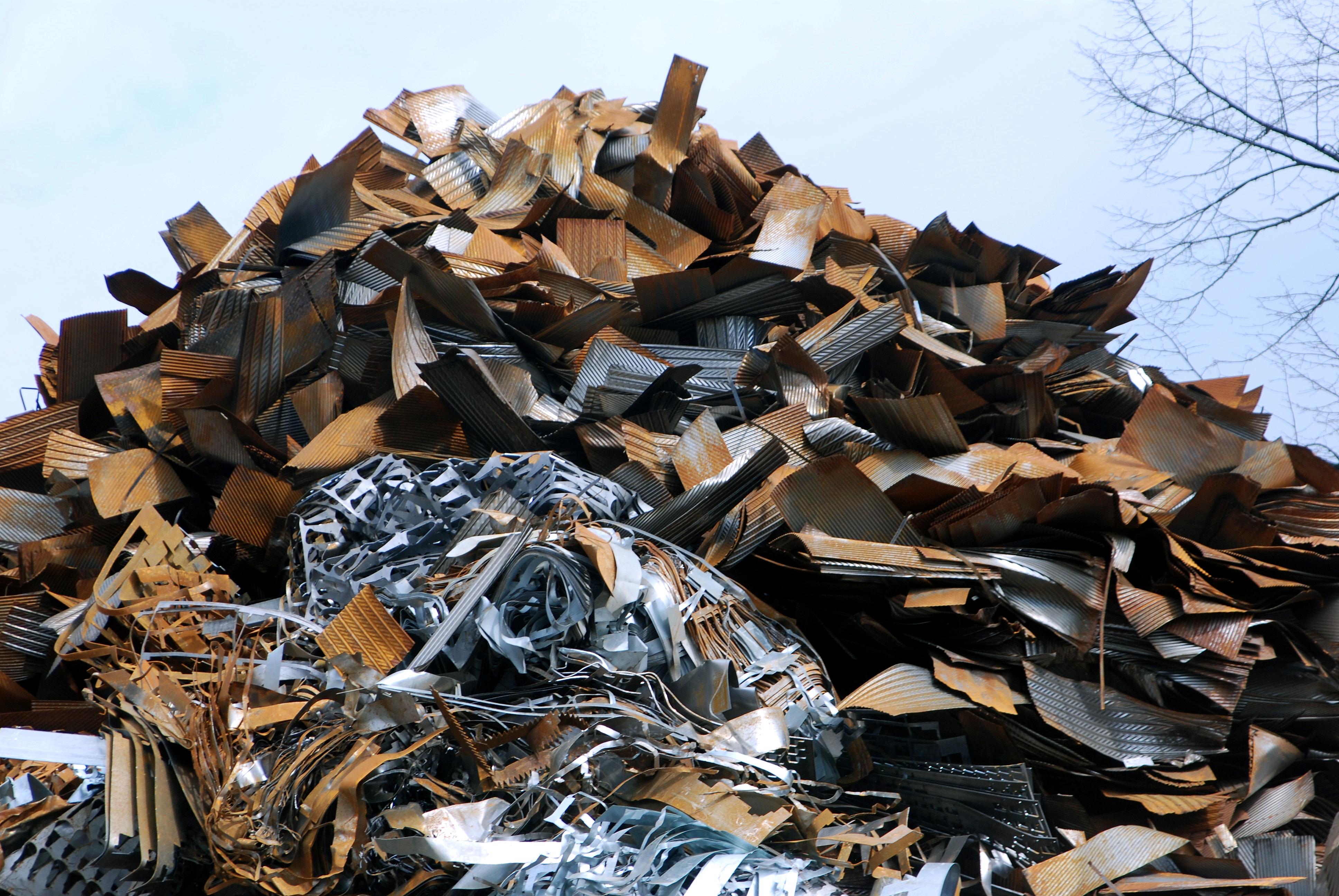
Dan - Well, anything that can't be recycled currently either has to go for landfill and landfill are engineered holes in the ground where we can still recover some of the energy out of material that goes into the ground. When it breaks down the organic content in there, it produces methane gas and we tap that gas off and burn it for electricity in the same way as we do using anaerobic digesters. So, material that can't be recycled goes to landfill for disposal mainly, although increasingly, we're looking to thermally treat it and still recover energy out of it.
Ben - We've mentioned anaerobic digesters. I mentioned in the intro that we apparently could be able to claim what seems to be an enormous amount of energy back from waste using these bits of kit. What are they and how do they work?
Dan - Well, an anaerobic digester as the name suggests, digests organic material in the absence of oxygen, so that is anaerobically. It is a good technology for a relatively narrow amount of the total waste stream - i.e. it has to be organic material, it has to be pre-segregated or separated out, and turned into a slurry. We then feed it into tanks where it's kept - well, you add water to it, feed it into tanks as a slurry and you have to have the right temperature for the bugs to start working, and the bugs start bubbling up in the absence of oxygen. They produce methane. We then tap that methane off and burn it through lean burn gas engines to produce power. It's already been used for quite a long time in the sewage industry for example and increasingly, we're using it within the standard waste industry for pre-separated food waste, kitchen waste, organic waste, and garden waste. If we can keep that waste stream separate then it's a good source of energy.
Ben - It sounds like a lot of preparation that you have to go into in order to actually be able to put the stuff in the digester in the first place. How does it compare in terms of the amount of energy to what we get out from just tapping the energy from - as you mentioned earlier - landfill and tapping the gases that come out naturally?
Dan - Well, it is more effective than that in the long run if you can keep the proportion of waste - and we're talking probably about 15 to 20% of normal household waste and certainly, more from catering waste in that type of establishment - so there are some commercial waste streams that are particularly suited to it. And it's always going to be more efficient, if you can segregate out those waste streams, to separate it out and get gas and energy from it in that way, rather than mixing in and trying to extract it once you've put it into a landfill site.
Ben - And with regards to the scale and positioning, what do you think is the best approach? Should we have one enormous one in the middle of the country that burns off all of our waste or should we have lots of little ones, perhaps backyard size ones or ones in villages, small towns, maybe even one at your local supermarket that just gets rid of your kitchen waste? What scale should we be looking at?
Dan - It's very much horses for courses. There are a hundred different things you have to look at when you're locating any waste treatment facility. One, you have to look at the waste streams, where they're coming from, how they're collected, whether they are already separated, or whether you're going to have to separate some of the materials out. And generally, there are economies of scale to be had by reasonably scaled facilities rather than lots and lots of little ones. They'll cost more, you have to find balance to keep them running properly, to keep them running efficiently, and therefore, they take a lot of care and attention in the operation of them, the environmental monitoring of them to make sure you're doing it properly and not causing further environmental issues for example as you go along. So, all of those things together mean that probably, centrally and sensibly located facilities dealing with waste streams from a fairly decent sized regional area are better than hundreds of little community facilities.
Ben - And what happens to the other products, presumably the electricity that you generate can just go back into the national grid and go to wherever it's needed. But the other products, all the excess water that you've needed to use and what's left, which I believe is called the "digestate"? Where does that all go?
Dan - Again, that depends on the setup of the kit that you're operating. The energy as you say, the electricity, is fed into the national grid. There is some heat in the form of hot water, you can produce and use on-site if you've got anything else on-site that could utilise such things. The water has to go in a controlled system and usually, it's re-used over and over again if it can be. Otherwise, it has to be safely discharged to sewer for treatment again, further treatment. The digestate itself again will very much depend on the material that you fed into the plant. What we're doing as a company - Viridor - in different parts of the country, we're producing a compost-like material that can be used for landscaping, soil blending, that type of thing. in other areas, it's actually dried out and then used as fuel or added into a fuel mix for thermal treatment where we'll squeeze even more energy out of it. So again, it very much depends on the waste streams that we're talking about.
Ben - So clearly, there's quite a lot to be thought about, but they seem to be a very useful, very efficient bit of technology, and that is Dan Cooke from Viridor.
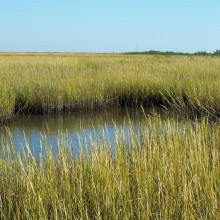
09:07 - Making the Most of Phosphates in our Waste.
Making the Most of Phosphates in our Waste.
with Cynthia Carliell-Marquet, University of Birmingham
Anaerobic digestion is clearly a good way to get energy back from our organic waste, but that doesn't tell the whole story. The digestate, the solid waste left behind, will contain lots of nutrients that can be returned to the ground as fertiliser.
But if this only happens close to the digesters themselves then we'll end up with a nutrient imbalance. Some areas will have too much and others will have too little.
I spoke to Cynthia Carliell-Marquet from the University of Birmingham to find out what the implications of these could be.
Cynthia - There is a lot of emphasis on anaerobic digestion in terms of the energy that we can recover from organic waste and the government has identified 20-30 million tonnes of food waste, 100 million tonnes worth of agricultural waste and there's about 2 million tonnes worth of sewage sludge waste, all off which can be anaerobically digested if we can construct enough anaerobic digesters.
The issue that hasn't been considered as fully as energy is the fact that in those wastes, there is specifically nitrogen and phosphorus which are more difficult to extract and recycle that energy.
Ben - Surely, if we are using a technique that allows us to keep hold of the nitrogen and the phosphorus, and then put it back on the land then surely, this is a good thing rather than just locking it away in a landfill somewhere?
Cynthia - It is a good thing. Returning the sludge of the digestate from anaerobic digester back to the land is a good thing. The problem or the challenge comes in from the fact that the digestate, even when it's dried, has quite a high concentration of water which makes it very bulky to deal with and to move around, and to store.
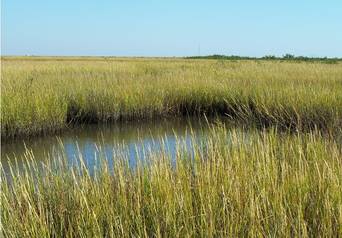 Generally, it would be quite difficult to transport it economically, more than about say, 20 miles in a radius from your anaerobic digester. So if you've got enough land to accommodate that digestate then yes, putting it back to the land with this nutrient potential is a really good use of it. The challenge comes in getting it back to where you need it to be, so getting it back from livestock areas, back to arable crop production for example.
Generally, it would be quite difficult to transport it economically, more than about say, 20 miles in a radius from your anaerobic digester. So if you've got enough land to accommodate that digestate then yes, putting it back to the land with this nutrient potential is a really good use of it. The challenge comes in getting it back to where you need it to be, so getting it back from livestock areas, back to arable crop production for example.
Ben - So we're going to end up with a very uneven distribution of nutrients and particularly, you've mentioned nitrogen and phosphorus. What is it about these two that we need to be cautious about?
Cynthia - They both have completely different issues. Nitrogen is quite energy hungry. It's freely available. We make nitrogen fertiliser from nitrogen in the atmosphere, but it's a reductive process and it uses a lot of energy. Phosphorus is a completely different issue. It's a finite resource. All the phosphate that we introduce into our agricultural system comes from phosphate rock mines. It's a non-renewable resource and there was some talk about 2 years ago that we were going to run out of phosphorus. That's been explored quite fully now and it seems that we're not going to run out ofphosphorus - at least in the short term. There isn't the urgency that surrounds some of the other minerals that we feel we're going to run out of much more quickly, maybe even within a decade. With phosphorus they're now looking at say, 370 years before we run out.
But the phosphate rock mining industry is, in itself, quite a polluting industry. It's not particularly sustainable to say "right well because there are quite a lot of reserves, we can just keep using this and then go and dig up some more, and re-use that".
So, it's a question of sustainability and trying to close resource loops, and trying to be more economical about the way that we use resources. The way that we use it is just not sustainable. I think we lose about 80% between Field and Fork. So about 80% of what we put on you know, does not end up in our food. So we mine an awful lot of this stuff. We put out on the fields, we do produce crops at the yields that we want, but it's just a very wasteful system.
Ben - What would be the impact on a given area if it ends up with not enough phosphorus? So we're just going to see farms unable to grow food anymore or is it a bit more substantial on the whole ecosystem?
Cynthia - Phosphorus is really an issue for farming, for food production. The yields that we manage to attain today that help to feed the world's population are, to quite a large extent, dependent on phosphorus fertiliser. If you don't have enough phosphorus and you don't have enough phosphorus in your soil then the yields will decline until it gets to a point that it will not be possible to produce enough food.
Ben - And is there a problem if we have too much of it, if too little will lead to reducing food crop? What will happen if we've got too much?
Cynthia - If you've got the right amount of phosphorus on your field then it'll be immobilised within the soil through precipitation reactions. But if you have too much phosphorus then it can be washed off the field into the water bodies where it performs pretty much the same job as it does in agriculture. Generally, phosphorus is a rate limiting nutrient. When you don't have enough phosphorus, it keeps plant growth in check. This is the same within rivers and all freshwater bodies. So when you get more phosphorus in the river then you get a big increase in plant growth or in algal growth, and this causes a problem to the whole river system, to the biodiversity of the river system, and it also causes a problem to people who use the water. Algal overgrowth for example is problematic in terms of extracting water, drinking water. Obviously, for farmers as well, it can be problematic if it changes the water course such that they can't use the water for irrigating their animals.
Ben - It sounds like we're in something of a Catch 22 situation really because we can't regain it from our waste products without things like anaerobic digesters but that will then be inefficient and expensive to transport it around the country. What solutions do you think we should be looking at?
Cynthia - The solutions have got to be done on a case by case basis. So, if the local situation is suitable for putting that manure or that digastate back to the land, that sounds like a very good solution. If the local situation is such that the area already has a phosphorus surface, in that case, there is a real need to get the phosphorus away from that area and one of the things you can look at is trying to extract the phosphorus from the digestate or from the animal manure and there's various chemical processes that you can use to extract the phosphate. Then you can try to re-crystallise it in some kind of mineral phosphate form that would be very similar to a mineral fertiliser. So forms of, for example, Struvite which is magnesium ammonium phosphate or calcium phosphate would mean that the phosphorus was in a much more manageable form which we could then store and transport pretty similarly to mineral phosphate.
Ben - Cynthia Carliell-Marquet from the University of Birmingham.
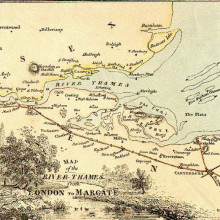
16:32 - Nitrates in the Thames - Planet Earth Online
Nitrates in the Thames - Planet Earth Online
with Dr Nicholas Howden, University of Bristol and Professor Tim Burt, Durham University.
Nitrates in water can harm newborn babies and trigger the rapid growth of algae in rivers, killing fish and choking plants. As a result, nitrates are removed from water supplies...but the amount of nitrates in the River Thames has trebled since the 1930s.
Scientists wanted to know why - so a team from the universities of Durham, Cranfield and Bristol has been studying how nitrates move through the land to end up in rivers, springs and other sources of water. To do this, they used a paper trail of archives containing records of water quality dating back 140 years.
Planet Earth podcast presenter Sue Nelson met two of the team members on the bank of the Thames in Central London - Dr Nicholas Howden, a senior lecturer in water at the University of Bristol and Tim Burt, Professor of Geography and Dean for Environmental Sustainability at Durham University. Sue began by asking Nicholas where the nitrates in the Thames have come from...
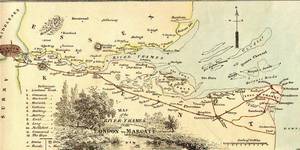 Nicholas - A proportion of the nitrate in the Thames has come from sewage effluent discharges. That has largely been controlled in the last 20, 30 years, there have been lots of new treatment processes put in place. A lot of that comes from point source discharges, so we can see them. We know where they are, we know who's discharging them and they've been largely cleaned up as much as they can be and regulated. The component that we've been mostly interested in, is looking at the diffuse sources - so those are the sources that are widely distributed throughout the Thames catchment. That's one of the largest catchments in the UK, and it's some 10,000 square kilometres. So it's a very big area and that predominantly is coming from our agricultural activity to grow food, so ploughing, fertilizing, use of animals and the natural processes of biological fixation and also, some atmospheric deposition as well. So, it's a combination of factors that have come from our use and our more and more intense use of the river catchment from which all of this water drains to then end up in the Thames.
Nicholas - A proportion of the nitrate in the Thames has come from sewage effluent discharges. That has largely been controlled in the last 20, 30 years, there have been lots of new treatment processes put in place. A lot of that comes from point source discharges, so we can see them. We know where they are, we know who's discharging them and they've been largely cleaned up as much as they can be and regulated. The component that we've been mostly interested in, is looking at the diffuse sources - so those are the sources that are widely distributed throughout the Thames catchment. That's one of the largest catchments in the UK, and it's some 10,000 square kilometres. So it's a very big area and that predominantly is coming from our agricultural activity to grow food, so ploughing, fertilizing, use of animals and the natural processes of biological fixation and also, some atmospheric deposition as well. So, it's a combination of factors that have come from our use and our more and more intense use of the river catchment from which all of this water drains to then end up in the Thames.
Sue - How does ploughing release more nitrates into the soil, Tim?
Tim - Well ploughing mineralises organic matter, it basically aerates the soil and you get organic matter being oxidised and that works through to first of all, ammonium salts and then though to nitrates. So it's really the aeration of the soil. It's what, in a sense, ploughing is actually about turning organic matter into nutrients which can then grow crops.
Sue - So does this mean then that during World War II, for example, when everybody was being encouraged to 'Dig for Victory', did you notice an accompanying spike of nitrate levels?
Tim - Yes, we did. In fact, in the first war as well, but the second world war in particular. There wasn't much use of fertiliser other than animal manures then, but the mere fact of ploughing and widespread ploughing, a huge increase in the area of land under the plough and that does show through. It showed through to an extent straight away, but it also showed through in a big delayed response which came several decades after the war. But yes, you can definitely see a link between 'Food for Victory' and all those sorts of campaigns and the water quality in the Thames decades later.
Sue - I know that, Nicholas, one of the important things here is about when you saw the link as well. It took time to get those nitrates from the surrounding land into the River Thames.
Nicholas - Yes, that's right. So what we've tried to do is to estimate what the inputs were in any particular year and then we've used this long record of what was going on in the river to try and match the inputs to the outputs using a series of stores. So in this case, two stores - one which is run off, so that's the water that hits the land and it makes its way to the river in that year. Then there's a second store which is a ground water pathway and so the water that falls in any particular year takes nitrate with it and then it ends up in the river some time later.
In producing our model, we allowed that delay time to vary up to a number of decades from zero to about 50 years or even more. What we found was, by using the estimated pattern of inputs that we'd come up by considering what fertilizers were used, how much ploughing there was, how many animals there were in any year, we were able to match that input to what we actually observed in the river, By doing that, we can estimate what these different delay times are and how long it takes for something we do in, say, 1940 to reach the river. It turns out the answer is, it reaches in about 1970 and the split is roughly 50:50. So a 50% of what goes onto the land comes out in that year and 50% is delayed by approximately 30 years.
Sue - That's incredible though isn't it?
Nicholas - Yes it is and we think this is very important because a lot of what we do, we think that if it doesn't have an effect shortly after we've done it then it doesn't have an effect at all. Whereas in actual fact to deal with this problem, we are going to have to think in terms of 50-year cycles, and that's because we're dealing with a natural system that has this natural time constant and it's very important that we start to understand this when we're setting policy objectives, when we're trying to understand how what we do now will affect the future.
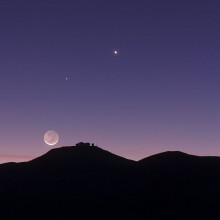
21:51 - Looking for Evidence of Life on Earth
Looking for Evidence of Life on Earth
Astronomers have found compelling evidence for life in the Universe - but only on Earth. Using a phenomenon known as Earthshine, where light from Earth is reflected off the surface of the Moon, researchers from the European Southern Observatory were able to view the Earth as if it were an exoplanet, and use the reflected light to look for tell tale signatures of life.
We can get a very good idea of the composition of something from the light it emits or reflects. Certain molecules leave their fingerprints in the spectrum of light, and our understanding of the chemistry of these molecules can give us a good idea as to what is going on. However, observing light from planets around other stars is challenging - any reflected or emitted light will be drowned out by the glare of the parent star.
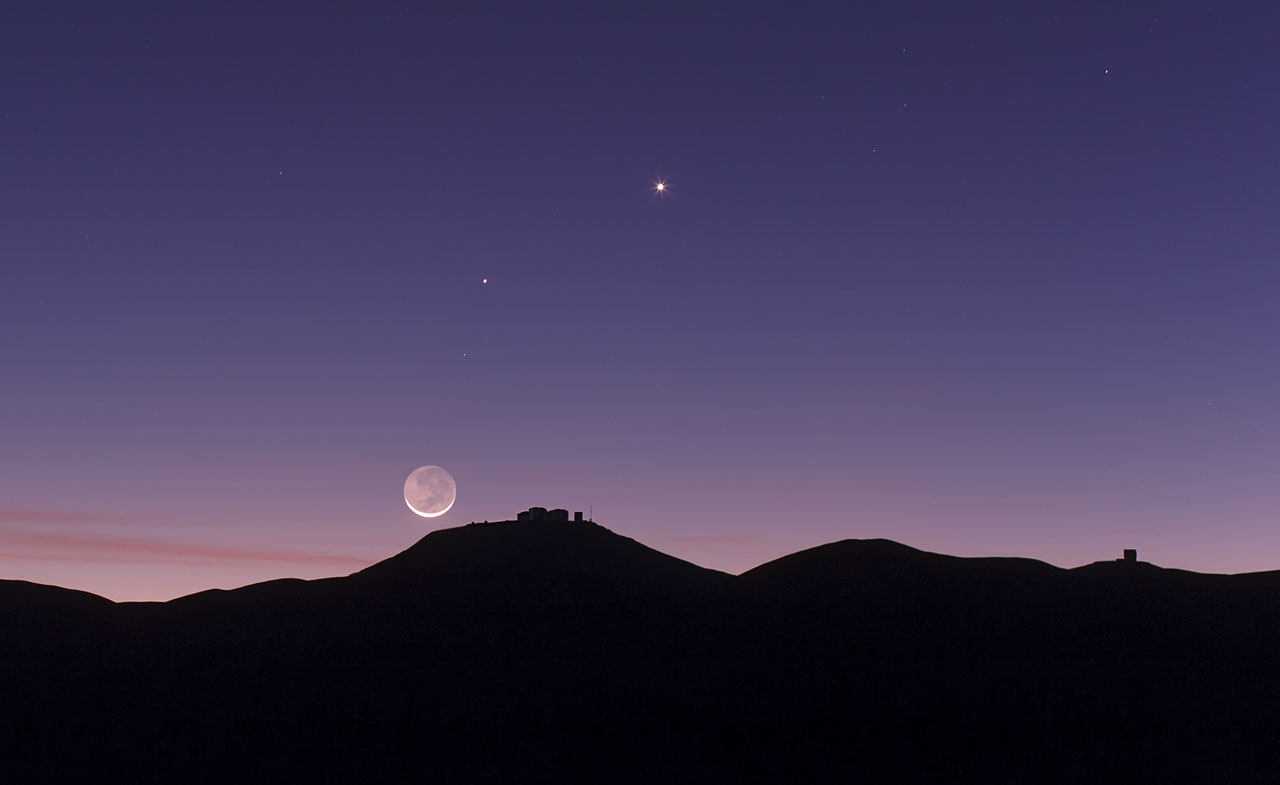 One solution comes in the fact that while emitted light, such as that from a star, will arrive in any and all orientations, reflected light is polarised - it comes in just one orientation. By looking at both the spectrum and the polarity, in a process known as spectropolarimetry, astronomers can look for chemical signatures in just the light reflected off a planet.
One solution comes in the fact that while emitted light, such as that from a star, will arrive in any and all orientations, reflected light is polarised - it comes in just one orientation. By looking at both the spectrum and the polarity, in a process known as spectropolarimetry, astronomers can look for chemical signatures in just the light reflected off a planet.
In this case, they were looking for biomarkers - evidence of certain combinations of gases in certain ratios that can only exist in the presence of life, such as molecular oxygen and methane. These chemicals can exist on a sterile planet, but settle into a different equilibrium in the absence of living organisms. They also looked for a "Red Edge" - a change in reflectance of near infrared radiation that indicates the presence of vegetation.
Using just Earthshine light, the researchers were able to determine the fraction of Earth's surface covered in seas, and that it has a cloudy atmosphere. Crucially, they could also detect the existence of vegetation, and could determine that it varied across the surface of the planet.
While the presence of life on Earth may not be news to us, it is proof that this technique works, and can be used in future to look for evidence of photosynthetic plant life elsewhere in the universe.

25:43 - Should We Trust the Upper Classes?
Should We Trust the Upper Classes?
with Paul Piff, University of California at Berkeley
Ben - Throughout history, a gentleman was something that the lower classes would defer to and would aspire to become...
But now, research reveals that, paradoxically, those most likely to indulge in unethical, ungentlemanly actions are actually the upper classes themselves!
Paul Piff led the team behind a study that proves this and he joins us now. Paul, what were you looking at? Why was this so interesting to a social scientist?
Paul - What we were, and have been, basically very interested in for the last few years in our laboratory work is how different levels of status and wealth shape individual patterns of behaviour. So how does wealth and your status relative to other people in society influence, and really inform, how you see the world and operate toward other people?
We've run dozens of studies that look at these very different kinds of behavioural patterns among upper and lower class individuals. In this most recent set of studies, we really wonder - very specifically examine - whether wealth and status would shape people's tendencies to behave unethically - their willingness to break the rules, or forego certain kinds of societal norms and standards in the service of their own self-interest. And so, we conducted a number of studies to look at this. In some, we conducted sort of naturalistic or field studies where we looked at whether drivers with more or less expensive vehicles were differently inclined to break certain kinds of laws whilst driving. And we also conducted a series of experiments in the lab to more directly test that question.
Ben - So take me through some of the other experiments you did. You've watched people to see whether or not they were likely to break the rules when driving an expensive car or a cheaper car. But other experiments relied on trusting people and their own self reporting. How did you do this and what were they telling you?
Paul - So, understandably, the kind of car, the kind of vehicle a person owns isn't a perfect indicator of their socio-economic status or their social class. So, we wanted to conduct a series of different laboratory experiments to more directly assess where a person ranks relative to others in society, how much wealth they actually have, and then associate that with their actual levels of unethical behaviour. So for instance, in one study, we brought a group of nationwide adult participants from all over the United States and told them that they would today, very lucky for them, get to participate in a game of chance where the computer would virtually roll a die for them five times. They would have to keep track of their scores. Higher scores in the game would be equal to better chances of winning a cash price, a $50 cash price.
So we asked participants to report their total scores upon the conclusion of all five rolls, but what participants didn't know was that we had rigged the game so that all scores across the board were going to be totalling up to 12. So there was really no way a participant could actually get a score higher than 12. By looking at the difference between what they reported and 12, we could see whether or not participants were actually cheating in this game to improve their chances of winning this cash prize.
And amazingly, what we found was that there was a very significant correlation such that even when accounting for a whole slew of other variables, as a person's socio-economic status increased, their tendencies to cheat in this game did as well.
In fact, the people all the way at the top of the socio-economic hierarchy were actually cheating by up to three times as much in this very simple game, relative to their lower class counterparts.
Ben - Well that's a very striking result. I was wondering, what do you think we can really conclude from this? Is it just that people who are wealthier and are more successful got there by being more selfish, or do you think it's the cause and effect is a bit mixed up?
Paul - I think that's a very, very nice and elegant point and your audience is probably wondering the same thing. Correlation obviously does not equal causation so it might very well be the case that unethical people are going to be those more likely or the most likely to also improve their material wealth.
So I imagine that there's going to be sort of a cyclical or self-perpetuating dynamic at play here. But at the same time, we've run a host of experimental studies where beyond just measuring a person's socio-economic status, we actually manipulate it and we do that in a few different ways, but across the board, what we find is even when people are made to experience a higher sense of social class, even if they're actually from lower class backgrounds, that experience of higher class actually causes them very directly to increase their unethical tendencies and increase their self-interest behaviour. This suggests that there really is a very specific effect associated with occupying or believing that you occupy a more privileged position in society with your tendencies to prioritise yourself, and prioritise the pursuit of self-interest, above the well-being and welfare of other people.
Ben - What do you think this tells us about our interactions in the real world? Politicians, for example, tend to be people from wealthier backgrounds. They tend to be very successful people in themselves. Does this mean that we should conclude really that we shouldn't trust politicians?
Paul - I don't think that's necessarily the implication at all. I think that again, it's important to point out that these are not sort of categorical differences that we're finding and it's not necessarily the case that if you're say, "rich" you're necessarily going to behave in an unethical way and also, if you occupy lower rungs in society, that's not to say that you're also going to then be more ethical.
But what I think our findings suggest is that it's not necessarily the people who are occupying the most privileged positions in society, whether that's powerful politicians or wealthy executives who work in companies or financiers that work on Wall Street, they're not necessarily the most inclined to think about first and foremost, the welfare of other people.
I think this is partly as a result of the particular culture that they inhabit in that professional and organisational setting. So, if you work in a place that really hones self-interest and says that the pursuit of competition and self-interest is above all else a good thing then it's likely that it could lead to some fairly socially pernicious consequences. But of course, some politicians are fairly public and people are directly observing of their behaviour. So I think in situations where there are very direct and specific repercussions to one's actions, that may go a long way in curbing what may otherwise be naturally unethical tendencies among those who are the most powerful in society.
Ben - That is Paul Piff from the University of California at Berkeley, with research published this week in the Proceedings of the National Academy of Sciences.

32:39 - Speech stopping ray
Speech stopping ray
If you have ever been annoyed by someone chatting in a meeting, or even in a concert, help mig ht be on its way.
ht be on its way.
Kazutaka Kurihara and collegues have built a device which can stop someone speaking from across a room. It takes advantage of an effect you may have noticed when talking on a very bad phone line - if there is a delay of about a quarter of a second between you saying something and hearing yourself it is almost impossible to talk, because your brain is listening to your speech as you are talking, and using that to control that speech. If you hear yourself slightly delayed the whole system gets confused and you start to stutter, and find it very difficult to talk at all.
So they have mounted a very directional microphone next to a very directional loudspeaker with a laser pointer for aiming. When they point the device at someone speaking, it picks up the noise coming from that direction, and then plays the sound back at them with a delay adjusted for the time sound takes to travel that distance, causing the speaker to stutter and have great difficulty talking.
They are not intending to manufacture these devices but the technology is very simple so it is inevitable that someone will, which brings up interesting ethical issues as it would be possible to point it at a lecturer for a laugh or more sinisterly use the device at a political meeting to silence a competitor.
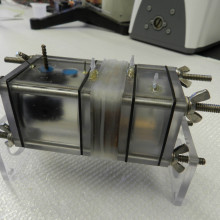
35:57 - Twinning Tech to make Electricity from Waste Water
Twinning Tech to make Electricity from Waste Water
By combining two existing but limited technologies, researchers in America have devised a novel way to generate electricity from waste water - and all it took was a pinch of the right salt.
The two technologies are Microbial Fuel Cells (MFC) and Reverse Electrodialysis (RED). MFCs use naturally occurring microbe species known as Exo-electrogenic bacteria, which break down organic matter and release electrons, creating a voltage.
 RED relies on a salinity gradient, using seawater and freshwater separated by a stack of selectively permeable membranes that only allow either positive or negative ions through. These membranes are connected to electrodes, and together contribute to an electric current. Each membrane only provides a small amount to the current, so a working RED cell requires many layers of membrane. To keep the supply of sea- and fresh-water, RED systems presently need to be built by the coast, and when using natural water sources, suffer from fouling unless the water is extensively filtered first.
RED relies on a salinity gradient, using seawater and freshwater separated by a stack of selectively permeable membranes that only allow either positive or negative ions through. These membranes are connected to electrodes, and together contribute to an electric current. Each membrane only provides a small amount to the current, so a working RED cell requires many layers of membrane. To keep the supply of sea- and fresh-water, RED systems presently need to be built by the coast, and when using natural water sources, suffer from fouling unless the water is extensively filtered first.
By combining MFCs with RED and feeding in waste freshwater, Professor Bruce E. Logan at colleagues at Penn State University were able to make a "Microbial Reverse-electrodialysis Cell" or MRC, that not only generated significantly more energy than a fuel cell alone, but also needed fewer membranes than a traditional RED.
By using ammonium bicarbonate as their salt source instead of seawater, they were able to increase the efficiency and sever the tie to coastal regions. Ammonium bicarbonate solution is easily produced using waste heat, and can be reclaimed and recycled within the system.
Logan and colleagues argue that this technology could tip the energy balance of water purification, as their system helped to purify waste water while generating 0.94 kilowatt-hours of electricity per kilogram. Traditional treatment of waste water with activated sludge consumes 1.2 kilowatt-hours per kilogram of organic matter. This would provide a strong incentive to build MRC treatment plants in energy poor areas - providing both power and sanitised water.
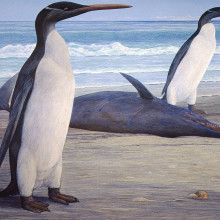
39:04 - Targeting Alzheimers, Sequencing the Iceman, Sex Selection in hippos and Giant Penguins
Targeting Alzheimers, Sequencing the Iceman, Sex Selection in hippos and Giant Penguins
with Li-Huei Tsai, MIT; Albert Zink, European Academy of Bolzana; Joseph Saragusty, Leibniz Institute for Zoo and Wildlife Research; Dan Ksepka, North Carolina State University explains
Protecting the memory of Alzheimer's patients
A
new drug targethas been identified to fight the memory loss and dementia seen in Alzheimer's patients.
Using mouse models, Li-Huei Tsai, from the Massachusetts Institute of Technology, identified increased levels of the enzyme Histone Deacetylase 2, or HDAC2, in mice with the disease.
The enzyme is known to play a role regulating the expression of genes involved with memory but it's increase can result in a blockade of these genes resulting in impaired memory formation and a decline in cognitive function.
Li-Huei - I think the good news from our study is that this blockade of impulses by the elevation of HDAC2 enzyme is potentially reversible. So, we are very hopeful that by coming up with inhibitors of HDAC2, that it will one day be possible clinically to recover cognitive function in Alzheimer's patients in terms of learning a memory.
--
Otzi the Iceman's Genome
 The
The
genome of Ötzi, the 5300 year old iceman, has been sequenced by scientists at the European Academy of Bolzana.
Previous studies have shown that Otzi, was over a metre and a half in height, lived in the Southern Alps and was killed at the age of 46 by an arrow. But now, his genome has revealed detailed characteristics of his physiology such as brown eyes, lactose intolerance and his blood group being O as well as a predisposition to certain diseases providing insight into not only his health, but also our evolution as Albert Zink explains...
Albert - So we found that he suffered from Lime disease and this is the oldest evidence for this disease that we have so far. He also has a genetic predisposition for coronary heart diseases. It was not known that this kind of diseases are that old. We know now better about his ancestry, that he belonged to a population that came to Europe in the Neolithics and nowadays, we have this kind of population still present in Sardinia and Corsica where we found the same genetic structure but in the rest of Europe, this signature is mainly replaced.
---
Favouring Females in Hippo populations
Male pygmy hippos change the composition of their sperm to reduce the number of males born into the next generation.
Working with endangered pygmy hippos in a captive environment, Joseph Saragusty from the Leibniz Institute for Zoo and Wildlife Research found that male members of the group produced sperm with higher levels of X chromosomes than Y chromosomes, meaning more females, of genotype XX, rather than males, of genotype XY, will be born into the next generation.
This results in less competition between the territorial males but could also be exploited to improve conservation methods.
Joseph - In many endangered species, it would be better if we could have a little bit more females than males because females are the ones that produce the offspring. Then we have a better chance to save populations from extinction. The next stage would be to find the mechanism how they do it and once we have this in hand, we might be able to influence this mechanism or activate it when we want to.
---
Reconstructing a Giant Penguin
And finally, a large, extinct penguin which lived 25 million years ago has been  reconstructed using fossil remains in New Zealand.
reconstructed using fossil remains in New Zealand.
The kairuku penguin, named after a Maori word for 'diver who returns with food', was pieced together using two incomplete skeletons of the bird revealing a penguin with a slender body plan, standing at 4ft 2 in height with an elongated beak and long flippers.
The penguin provides new insight into the ecosystem of New Zealand at this time period, as Dan Ksepka from North Carolina State University explains.
Dan - It turns out there's 5 different penguin species of all different sizes living side by side at about 27 million years ago. So this is part of a fauna of penguins. They're a very, very important component of that ecosystem and based on their evolutionary relationships, we see that these penguins are actually a side experiment. They are a branch of the penguin tree that separated from the main trunk, evolved for several million years and they were very successful during that time. But ultimately, they died out and did not leave any living descendants but during that time, very, very important to the ecosystem.
The work was published this week in the journal Vertebrate Paleontology.
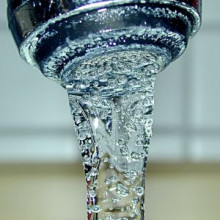
44:12 - Managing our Water Supply
Managing our Water Supply
with David Butler, Exeter University
Dave - It's looking like it would be a very dry, hot year this year in the UK with some reservoirs currently about 20% lower than normal. So good water management practices are essential. David Butler is from Exeter University where he's professor of water engineering. Hello, David. How much water do we actually use in a day?
David - We all use individually about 150 litres, so just imagine a litre bottle of water that you might have in your fridge. That's a 150 of those we all use.
Dave - So, how much of that is actually vital that we can't reduce as it were?
David - Of that 150, the amount that we actually drink or cook with is far, far less. Perhaps just something like 1/10th of that. 10 or 15 litres.
Dave - So we've got this huge amount of water we're using and I guess agriculture must be putting a lot more on top of that. So, what are our options if it's kind of getting dryer and we're getting higher population? What are our options to improve our use of water?
if it's kind of getting dryer and we're getting higher population? What are our options to improve our use of water?
David - You know, we're being squeezed on all sides really as you say with climate changing and with a growing population. So, we need to try and attack the problem in a number of different ways right from the small scale up to the large scale. So I think it starts really, individually in the house. We need to be perhaps more efficient in the way that we use our water in our everyday life. Because of course, we can recycle water in the household as well. We can take our gray water from sinks and showers, and re-use that for flushing toilets for example. So that would potentially reduce our water consumption by up to a third.
Dave - So what do that actually involve? Does that involve changing the plumbing of a house?
David - Yes, it would do a little bit. You would need a system that drained your shower and your sink and collected it into a tank somewhere in the household and then some form of treatment and a pump to get it back to your toilet.
Dave - But you're still left with that 2/3 of our water usage. So what can you do with that?
David - Another angle to this is to think about how water is actually delivered to the household. Although we use this 150 litres, the pipe system that brings the water to the household also does leak to a certain extent and typically now, leakage levels are something like 20%. So 20% of all the water that's delivered is lost along the way.
Dave - That's really scary. Is that sort of just because there's a very, very old infrastructure in the UK?
David - Yeah, that's right and the water companies have been working hard at reducing those levels. Not so long ago, they were up at 30% plus, so they've been pushed down now by careful management and by renewing some of the very old pipe work that we have in the UK.
Dave - Okay, so we're trying to save water that are coming into the house and when it's in the house. But at some point, we're going to want to get rid of all of these waste water. What do we do with it then?
David - Well, with waste water itself, that can be another resource of water. At the moment, it's very common for our waste water to be treated at a series of treatment works and then that will be discharged into a local river. It's then not uncommon downstream for the next town to take that water out, treat it to drinking standards and to use it. So actually, it's one integrated water cycle.
Dave - So essentially, you can keep recycling the water. Is there a limit to how often you can recycle water?
David - I don't think there's a limit as such. Look at the river Thames and think of all the towns up and down the river Thames and with London at the mouth of the river, the water itself has been used and re-used many times. I think the difficulty can arise if you do that in too tight a loop. That's a very loose open loop, you're taking water in and out of the environment, But once you tighten that loop very closely, then I think there could be some danger of pollutant build up.
Dave - So we've got various different approaches. But I guess the first thing, if you're a politician, you want to know what's the best bang for your buck - where should we be first spending our money in this way?
David - Well I think where we should probably try and spend our money is first of all, to make sure that we use less water. One way of doing that is for metering of properties. Across the UK now, something like 30% of households only are metered and studies have shown that households with meters tend to use less water, maybe 10% or so less water. So, merely the act of putting a meter in seems to reduce water consumption. So that's probably as good a place to start as possible. Otherwise, you're into very large scale engineering works such as constructing new reservoirs.
Dave - I guess in other countries, that leads on to the other half of water management and that's floods. I mean, it doesn't seem very long ago, just into kind of wading around in lots of water. Is there any way of storing that, reducing the flooding problem and storing more water for when we really need it?
David - Yeah. It's a bit of a holy grail that is and you're right. One minute since we have a drought and the next minute we seem to have a flood. And I think that's something to do with climate change that we're seeing this variability and we're seeing more extremes being predicted and we're seeing more extremes. What can we do about it? Well probably, storage is the answer and rainwater harvesting is one possible way to do that. You can collect rainwater from your household roof. Now if you put a big enough tank in there, that means you can use some of that water for toilet flushing for example and therefore save water and if the tank is big enough, the space there to collect rainwater, to stop it running off and causing flooding.
Could use our own waste as a source of power?
I'm not sure about the collecting it at home exactly how you'd produce power from it in that way. We do in some parts of the UK use human waste - once it's had tertiary treatment, it can be dried out, produce a cake and that is actually used at the likes of some cement kilns and some power stations. So, that does actually happen. A lot of it still has good nutrient in it and most places, once it's treated, it's still used as a good old fertiliser!
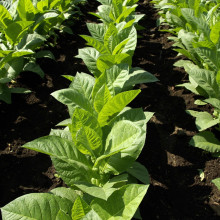
Could we use grey water to water fruit trees and crops?
David - Yes. I think I would be perfectly happy to water my flowerbeds with grey water but I think I would be just a little bit cautious about watering fruit or vegetables that you were going to eat, just as a precautionary measure.
Ben - So what sorts of problems could you actually build up in there? Is it going to fill up with pathogenic bacteria or is it purely just a case of, "We know it's been used, we know it's got the chemicals in it from say, your shampoo, and they may impact on the soil quality".
David - It's both of those. I mean, there's the shampoo chemicals that might be taken up by the plant and certainly, even though this grey water comes from maybe the sink, it can also come from the shower and the bath. That can also have pathogenic bacteria in it. Ben - He also mentions another one which is the runoff the drip collected from an air-conditioning unit. Now air-conditioning, essentially the water that comes out, is distilled water. Is that likely to be a problem? Presumably, it's going to be pure and clean, and really healthy water, but is it an issue to be putting distilled water on our plants?
David - No, I don't think that's an issue but I would just be slightly cautious with air-conditioning units of any type because of the issue of legionella which can cause Legionnaires' disease in very extreme circumstances. Now I'm not suggesting it would cause a problem in this case, but I would be cautious with that water.
Can we re-use the ash from burning waste?
Yes. There are two types of ash that come from thermal treatment - one is known as incinerated bottom ash and that's the majority of it which is the clinker that drops out of the bottom of the furnace if you like. That can be safely recycled and used as good quality aggregate and that happens already. They take the metals out, any metals that are left in it, and again those various metals are recycled. The bottom ash itself is used as aggregate for road building, for block making, et cetera. The interesting bit and where the science bit comes in, I guess, is the other type of ash - known as air pollution control residue - which is where you've injected lime and carbon, and things, to remove any pollutants. Increasingly, we're looking to re-use that particular type of ash in the manufacture of gypsum or the replacement of gypsum for gypsum board and such like. So, science is being applied to look at new ways of recycling that because everything about both thermal treatment and energy recovery as well as the rest of the waste and recycling industry these days is all about getting the most resource efficiency that we can out of all the materials we use as a society.
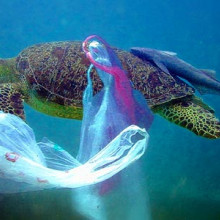
55:12 - When will indestructible plastics finally degrade?
When will indestructible plastics finally degrade?
Hannah - We backed the answer from Mark in Minnesota.
Mark - My name Mark Hillmyer and I'm Professor of Chemistry and the Director of the Centre for Sustainable Polymers at the University of Minnesota. Plastics represent an amazing class materials called polymers. These long chain molecules have remarkable properties and as we know, find use in nearly all aspects of our lives. Their broad applicability is due in part of their durability and resistance to degradation. However, this resistance to degradation is one of the pitfalls of plastics when they end up as trash in our environment. Unfortunately, a large quantity of our plastic trash ends up in the ocean and negatively impacts ocean life and the health of our ecosystems. Scientists and engineers across the globe are now grappling with this daunting environmental issue. So while you might think they would quickly corrode, dissolve or otherwise be broken down soaking in our oceans, this is not the case. Most plastics are made from simple oil derived compounds and thus are very hydrophobic or water hating.
In fact, plastics that have lived their useful life decades ago have been found floating in the pacific ocean, providing compelling evidence for their robust nature. Eventually, plastics that do end up in our oceans will break down through mechanical abrasion, oxidative degradation and other chemical, and sometimes biochemical processes. But this can take literally 100 years or more, depending on the specifics of their chemical composition. Making the situation worse, plastics are generally resistant to sunlight. Next generation polymers are being designed to be durable and used but readily broken down after disposal. Getting away from petroleum starting materials and generally new plastics that do not present such environmental hazards are important sustainability challenges in the world of polymers.
Hannah - And what happens to all of this plastic floating around in our oceans? Richard Thompson, Professor of Marine Biology at Plymouth University explains his experiments.
Richard - I work with common mussel, Mytilus edulis which is the same species as you'd have with mussels in chips if you like - moules frites. We've shown the work with them that if you give them a false exposure to small pieces of plastic in the laboratory, you move them to clean conditions where there's no plastic, even 40 days later, some of those individuals have still got plastic in their gut. So there's clear evidence that a range of creatures, a range of small invertebrates are eating plastic, and indeed are retaining that material.










Comments
Add a comment